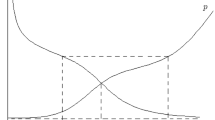Abstract
In its first sections, the paper deals with optimum thrust nozzles of given length and exit radius for flows with swirl. The computation is based on a modification of methods familiar for flows without swirl. Rather extensive numerical results show that the swirl does not impair the specific impulse attainable at a given nozzle length. The analysis suggests that the assumption of isentropic continuous flows, on which this approach is based, may sometimes be too restrictive. A survey of plane nozzles shows, on the other hand, that discontinuities need to be admitted only if, besides the length, a rather large radius of the nozzle is prescribed. Discontinuous solutions have been thoroughly investigated by Shmyglevskiy. At least in principle, we use the same line of thought, but considerable simplifications are possible if one starts with the variational formulation of Rao. In its numerical discussion and also in some analytical details, the present paper goes beyond Shmyglevskiy's results. The problem is conveniently discussed in astate plane, which has the local state of the flow (flow direction and speed or Mach number) as independent variables. By taking into account second variations, one can determine the boundary of the region for which continuous solutions give the (local) maximum. This boundary coincides with the locus of points at which the solution in the physical plane would fold back into itself. Another limitation of the original approach emerges if one asks under which conditions the thrust can be increased by admitting along the control surface values of the entropy that are higher than those of the oncoming flow. The conditions for isentropic and nonisentropic jumps are formulated and evaluated next, and a survey of the discontinuities which satisfy conditions for isentropic and also for selected nonisentropic jumps is given. Up to this point, the analysis is concerned only with the state distribution along the control surface. Jumps of the state in the interior require the occurrence of centered compression waves. Sample computations show that, in most cases, flow fields of this character can be generated by the choice of the nozzle shape. In some cases, no nozzle contours exist which generate the optimizing state distribution along the control surface as determined by the present analysis. It would then be necessary to include from the very beginning conditions for the realizability of the flow field.
Similar content being viewed by others
References
Guderley, K. G., andTabak, D.,On the Determination of Optimum Supersonic Thrust Nozzles of a Given Length for a Flow with Swirl: Theoretical Part, Office of Aerospace Research, United States Air Force, Report No. ARL 66-0013, 1966.
Guderley, K. G., andBreiter, M. C.,On the Determination of Optimum Thrust Nozzles of a Given Length for a Flow with Swirl: Numerical Results, Office of Aerospace Research, United States Air Force, Report No. ARL-70-0161, 1970.
Guderley, K. G., andHantsch, E.,Beste Formen fuer Achsensymmetrische Uberschallschubduesen, ZFW, Vol. 3, pp. 305–314, 1955.
Nikol'skiy, A. A.,Concerning Bodies of Revolution with a Duct which Possess Minimum Wave Drag in Supersonic Flow (in Russian), Collection of Theoretical Works on Aerodynamics, Oborongiz, Moscow, USSR, 1957.
Rao, G. V. R.,Exhaust Nozzle Contour for Optimum Thrust, Theory of Optimum Aerodynamic Shapes, Edited by A. Miele, Academic Press, New York, New York, 1965.
Guderley, K. G.,The Role of Rao's Postulate in the Optimization of Thrust Nozzles of a Given Length, ZFW, Vol. 18, pp. 41–44, 1970.
Guderley, K. G.,On Rao's Method for the Computation of Exhaust Nozzles, ZFW, Vol. 7, pp. 345–350, 1955.
Guderley, K. G., andBreiter, M. C.,Approximation for Swirl Flows in the Vicinity of the Throat of a Laval Nozzle, Office of Aerospace Research, United States Air Force, Report No. ARL-70-0009, 1970.
Shmyglevskiy, Yu. D.,Some Variational Problems in Gasdynamics (in Russian), Computing Center of the Academy of Sciences, Moscow, USSR, 1963.
Naumova, I. N., andShmyglevskiy, Yu. D.,Increase in Nozzle Thrust by Flow Rotation, Izvestiia Mechanika Zhidkosti i Gaza, pp. 34–37, 1967.
Author information
Authors and Affiliations
Rights and permissions
About this article
Cite this article
Guderley, K.G., Tabak, D., Breiter, M.C. et al. Continuous and discontinuous solutions for optimum thrust nozzles of given length. J Optim Theory Appl 12, 588–628 (1973). https://doi.org/10.1007/BF00934781
Published:
Issue Date:
DOI: https://doi.org/10.1007/BF00934781




